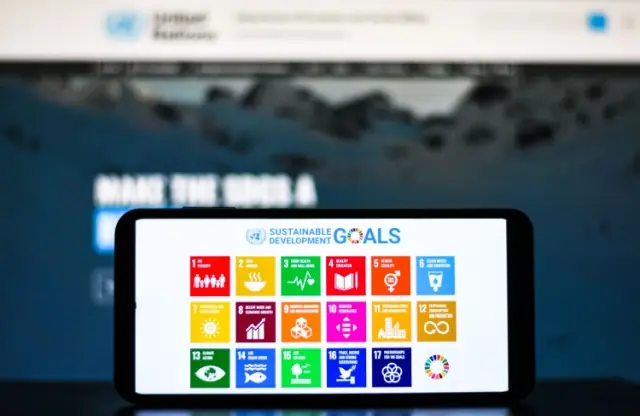
GRI Standards and their Benefits to Companies
 Share
Share
 Copy Url
Copy Url

GRI Standards are the gold standard in sustainability reporting. They offer a comprehensive framework for organizations to disclose their environmental, social, and governance (ESG) performance. By adopting GRI Standards, companies can enhance transparency and accountability. These are crucial elements in today's business world. This sustainability reporting framework supports companies in their journey towards sustainable development. It provides a structured approach to report on their impact. The benefits are clear: improved stakeholder trust, better risk management, and alignment with global sustainability goals.
In this article, we'll delve deeper into the Global Reporting Initiative (GRI) and its importance. We'll explore the key characteristics of GRI Standards. You'll learn about the three main reporting standards it encompasses. We'll cover the reporting principles of GRI Standards and the benefits of implementing them in your reports. Additionally, we'll guide you through the GRI reporting process and explain how to use these standards effectively. Whether you're a seasoned sustainability professional or new to ESG reporting, this article will provide valuable insights. Join us as we uncover who can use the GRI Standards, their mandatory status in some countries, and their limitations.
Global Reporting Initiative (GRI)
The Global Reporting Initiative (GRI) is an international independent organization that helps businesses, NGOs, governments, and other organizations better understand and communicate the impacts of their activities on the economy, environment, and society, including key challenges such as climate change, human rights, corruption, etc.
GRI was founded in Boston in 1997 in the aftermath of the Exxon Valdez oil spill to address the public outcry. Intending to create a mechanism for companies to adhere to responsible environmental principles, the organization grew to include social, economic, and governance issues as well.
The GRI moved its headquarters to Amsterdam, Netherlands in 2002. The GRI Secretariat facilitates standardized reporting for thousands of organizations globally across sustainability metrics and helps companies report in a transparent, clear, and comparable format. GRI has an additional 7 regional offices to enhance the support and services it provides to organizations and stakeholders worldwide.
Importance of the Global Reporting Initiative (GRI)
The Global Reporting Initiative (GRI) plays a crucial role in sustainability reporting. Here are the key points highlighting its importance:
Comprehensive Framework
GRI provides a widely recognized framework for sustainability reporting. It helps organizations disclose their environmental, social, and governance (ESG) performance effectively. This framework supports companies in meeting global sustainability goals and improving their sustainability performance.
Enhanced Transparency
By adopting GRI reporting standards, organizations can enhance transparency and accountability. This increased transparency helps build trust with stakeholders, including investors, customers, and the public, thereby strengthening the organization's reputation.
Improved Stakeholder Engagement
GRI emphasizes stakeholder engagement. The standards guide companies to consider the interests and expectations of various stakeholders. This leads to more informed decision-making and better alignment with stakeholder needs.
Risk Management
Implementing GRI standards helps organizations identify and manage risks related to sustainability. This proactive approach can mitigate potential negative impacts and enhance long-term business resilience.
Alignment with Global Standards
The GRI standards are aligned with other international frameworks for sustainability reporting. This makes it easier for organizations to meet various reporting requirements and ensures their reports are comparable globally.
Support for Sustainable Development
The GRI framework promotes sustainable development by encouraging companies to report on their contributions to economic, environmental, and social progress. This helps organizations align their strategies with sustainable development goals (SDGs).
What are the GRI Standards?
The GRI Standards, or GRI Reporting Standards, are a globally recognized framework for sustainability reporting. They enable organizations to disclose their economic, environmental, and social impacts in a structured and transparent manner. Thousands of reporters from over 100 countries use them. This helps assess and communicate the impact of their activities. As a result, they create economic, environmental, and social benefits.
The GRI Standards were developed through collaboration. Businesses, investors, policymakers, civil society, labor organizations, and experts all contributed. This multi-stakeholder process ensures a comprehensive approach to sustainability reporting. It enhances the transparency of sustainability reporting. It also helps organizations align their practices with the UN Sustainable Development Goals (SDGs). Additionally, the GRI Standards allow for consistent comparisons. Organizations can compare impacts, actions, and results over time and between different entities.
The GRI Standards are divided into three main categories. The Universal Standards provide the foundation for all reporting. They cover essential topics like governance and strategy. Sector Standards offer extra guidance for specific industries. This ensures that reporting is relevant to sector-specific impacts. Topic Standards provide detailed guidance on specific sustainability issues. These include climate change, human rights, and corruption.
These standards increase the transparency of sustainability reporting. They enhance stakeholder engagement. They also help organizations manage risks more effectively. By setting clear goals, tracking progress, and continuously improving, organizations can significantly enhance their sustainability performance using GRI Standards.
The Key Characteristics of GRI Standards
The Global Reporting Initiative (GRI) Standards are renowned for their comprehensive framework. They enable organizations to report their economic, environmental, and social impacts transparently. Here are the key characteristics of the GRI reporting standards:
Multi-Stakeholder Development
GRI creates its standards through a collaborative process. This involves businesses, investors, policymakers, civil society, labor organizations, and experts. This process ensures a broad perspective in sustainability reporting.
Comprehensive Framework
The standards cover a wide range of topics across economic, environmental, and social dimensions. This broad scope helps organizations report on all significant aspects of their sustainability performance.
Transparency and Credibility
GRI reporting standards enhance the quality and credibility of sustainability standards. They need detailed disclosures, ensuring stakeholders receive accurate and reliable information.
Regular Updates
GRI regularly revises the standards to reflect the latest sustainability issues and best practices. This keeps the reporting relevant and aligned with emerging global challenges.
Materiality Focus
GRI emphasizes the importance of materiality. This helps organizations identify and report on the sustainability matters most significant to their stakeholders and business operations.
Compatibility with Other Frameworks
GRI Standards are compatible with other reporting frameworks, such as the Corporate Sustainability Reporting Directive or CSRD. This compatibility makes it easier for organizations to meet many reporting requirements simultaneously.
Sector and Topic Specificity
The standards are divided into Universal, Sector, and Topic Standards. Universal Standards provide a foundation. Sector and Topic Standards offer detailed guidance relevant to specific industries and issues.
Global Applicability
Organizations of any size, sector, or location can use GRI Standards. This universal applicability promotes widespread adoption and standardization in sustainability reporting.
These characteristics help organizations use GRI Standards to improve their transparency, stakeholder trust, and sustainability performance. They meet the quality and credibility expected in global sustainability reporting.
The Three GRI Reporting Standards
The GRI reporting standards provide a comprehensive framework for sustainability reporting. They allow organizations to disclose their economic, environmental, and social impacts transparently. There are three main types of GRI reporting standards. They are Universal Standards, Sector Standards, and Topic Standards. These standards enhance the quality and credibility of sustainability standards globally.
Universal Standards
Universal Standards apply to all organizations. They provide the foundation for sustainability reporting.
- GRI 1: Foundation 2021 explains how to use the GRI Standards and sets the requirements for reporting.
- GRI 2: General Disclosures 2021 covers organizational details like governance and stakeholder engagement.
- GRI 3: Material Topics 2021 guides organizations in identifying and managing significant sustainability issues.
Sector Standards
Sector Standards offer specific guidance tailored to different industries. They ensure sustainability reporting addresses sector-specific impacts. This promotes the comparability of sustainability reporting across similar organizations. For example, the standards for the oil and gas, agriculture, and mining sectors include detailed disclosures relevant to these industries.
Topic Standards
Topic Standards focus on particular sustainability issues, such as climate change, human rights, and anti-corruption. Each Topic Standard provides detailed disclosures that organizations must report on. This helps them address specific sustainability matters. Detailed reporting supports corporate transparency and helps stakeholders understand an organization’s performance on critical issues.
Incorporating these standards can significantly benefit sustainability reporting in India. The Business Responsibility and Sustainability Reporting (BRSR) framework in India aligns with GRI standards. This alignment helps companies improve their sustainability practices and reporting quality. It ensures that Indian businesses meet international sustainability expectations and enhance their global competitiveness.
The GRI reporting standards are essential for fostering transparency, improving stakeholder trust, and driving sustainable development. They provide a robust framework for organizations to report their impacts and improve their sustainability performance continuously.
Reporting Principles of GRI Standards
The principles are divided into two categories:
Principles for Defining Report Content
- Materiality – Significantly, the report has information and disclosure on topics and indicators of corporate economic, environmental, and social impacts of the business. This will help stakeholders analyze the company and make appropriate decisions.
- Stakeholders Inclusiveness – It is imperative that stakeholders' interests and concerns be taken into consideration. For this, the reporting organization must first identify its stakeholders and explain how it has responded to their specific concerns and queries.
- Sustainability Context – This principle is about the sustainability report being presented in a manner that indicates what the company's current situation is vis-à-vis economic, social, and environmental factors and what the company plans to do in the future. This should include both – the way the company contributes to these areas and the company’s actions that negatively impact these areas.
- Completeness – The boundaries of the scope of the report (information on significant social, economic, and environmental impacts) must be clearly presented to give readers the necessary information to assess the company’s performance during the period in question.
Principles for Defining Report Quality
- Balance – The report must be impartial, objective, and balanced so that the positive and negative performance results are stated.
- Comparability – Comparability is a core aspect of a GRI-compliant sustainability report. A company or reader must be able to compare reports from one year to the next or with reports of competitors, different industries, sectors, economies, etc.
- Accuracy – The qualitative and quantitative measurements used in the report must be sufficiently accurate to allow readers and stakeholders to make reliable assessments of performance.
- Timeliness – Your report must disclose the information promptly for stakeholders and readers to make well-informed and well-thought-out decisions. The information disclosed will only be of any use if released regularly or periodically.
- Clarity – The information reported must be understandable and accessible to stakeholders.
- Reliability – The information must be gathered, recorded, compiled, analyzed, and reported in such a way that it is easy for stakeholders and other readers to examine it and make decisions.
Benefits of implementing GRI Standards in your Report
- Sustainability Reports that are based on GRI Standards will act as a tool for comparing non-financial disclosures across borders of countries.
- Due to the international nature of GRI, reporting using the standards will give them further credibility in foreign markets.
- GRI Standards will help companies align themselves with the Sustainability Development Goals of the United Nations.
- With discussions ongoing to develop the Integrated Reporting framework along with GRI principles, companies can potentially use the learnings from GRI Standards even when creating an integrated report.
- Creating a sustainability report as per GRI standards makes reporting and disclosure methods more seamless.
- It can help corporations consolidate their market position in the long term.
- A GRI-based report will enhance investor and stakeholder confidence in your company by providing transparent and comprehensive disclosures, thereby highlighting the long-term value-generating potential of the company.
- Once companies have gotten into the practice of collating information, assessing material data, and reporting clearly and transparently, this can be an established process of corporate governance.
The GRI Reporting Process
The GRI reporting process is a structured approach for organizations to disclose their sustainability impacts effectively. This process ensures the quality and credibility of sustainability standards and promotes the comparability of sustainability reporting.
1. Preparation
Organizations start by identifying their stakeholders and understanding their concerns. They assess the impacts on the economy, environment, and society. This step involves gathering information and setting the report's scope.
2. Stakeholder Engagement
Organizations engage with stakeholders to gather input and ensure the report addresses their concerns. This helps in identifying significant sustainability impacts.
3. Materiality Assessment
Organizations conduct a materiality assessment to determine the most important topics. This step identifies core indicators reflecting significant economic, environmental, and social impacts.
4. Data Collection and Analysis
Accurate data collection is crucial. Organizations gather relevant data on the identified material topics to ensure the information is reliable and comprehensive.
5. Reporting and Review
Organizations compile the data into a structured report following GRI reporting standards. They ensure the report covers all material topics and core indicators. The report undergoes internal review to ensure accuracy and completeness.
6. Publication and Communication
The final report is published and communicated to stakeholders through various channels. Organizations also notify GRI of the report's publication.
By following this process, organizations can enhance corporate transparency and stakeholder trust. They improve their sustainability performance and follow frameworks like BRSR in India, aligning with global sustainability expectations.
Who can use the GRI Reporting Standards?
The GRI Reporting Standards are designed to be versatile and applicable to a wide range of organizations. Here’s a detailed look at who can use these standards:
Businesses of All Sizes
Both small and large companies can use the GRI Standards to report on their sustainability impacts. These standards provide a flexible framework that can be adapted to the needs of various business scales, helping to enhance transparency and accountability.
Public and Private Entities
Public sector organizations, including government bodies and non-profits, can use the GRI Standards to report on their sustainability performance. Private entities, such as corporations and small to medium enterprises (SMEs), also enjoy using these standards to disclose their sustainability efforts comprehensively.
Sector-Specific Organizations
The GRI Standards include Sector Standards tailored for specific industries. These standards address the unique sustainability challenges and impacts of different sectors, such as agriculture, oil and gas, and mining, making them relevant for industry-specific reporting.
Global Reach
Organizations from any geographical location can use the GRI Standards. These standards are globally recognized and applicable. Which helps in supporting organizations worldwide in their sustainability reporting efforts.
Investors and Policymakers
Investors use GRI reports to assess the sustainability performance of their investments. Policymakers and regulatory bodies can also use these reports to understand and regulate corporate sustainability practices.
Non-Governmental Organizations (NGOs)
NGOs can use the GRI Standards to report on their social and environmental impacts. This helps ensure that they remain accountable to their stakeholders and funders
The GRI Standards are designed to be inclusive and adaptable, supporting a diverse range of organizations in their efforts to enhance sustainability transparency and performance.
Are the GRI Reporting Standards Mandatory?
The GRI Standards are not universally mandatory but are integrated into various regulations to enhance corporate transparency and sustainability reporting. Here are key points about their adoption:
European Union (EU)
The EU’s Corporate Sustainability Reporting Directive (CSRD) requires large companies to disclose their sustainability impacts. This aligns with GRI Standards, providing a compliance framework.
South Africa
The Johannesburg Stock Exchange mandates integrated reports from listed companies. Many use GRI Standards due to their comprehensive framework, although not explicitly required.
India
India’s Business Responsibility and Sustainability Reporting (BRSR) framework mandates the top 1,000 listed companies to disclose sustainability performance, aligning closely with GRI Standards. The Securities and Exchange Board of India (SEBI) encourages GRI Standards to improve sustainability reporting quality and comparability. This helps Indian companies meet international best practices and investor expectations.
International Organizations and Specific Sectors
Bodies like the International Council on Mining and Metals (ICMM) need members to adhere to GRI Standards. This makes compliance "virtually mandatory." In sectors like the extractives industry, they use standards such as GRI 11: Oil and Gas Sector to meet stakeholder and regulatory demands.
While GRI Standards are not globally mandated, they are increasingly essential for compliance in specific regions and industries. This trend highlights the growing importance of sustainability reporting in corporate governance and regulatory frameworks worldwide.
Starting Your GRI Reporting Journey with Report Yak
A company that is starting its reporting journey using the GRI Standards can find it overwhelming. Planning and collection of data must begin several months before when an organization wants to launch its report. Some organizations start collecting information and undertake materiality assessments as early as a year prior to releasing their report.
In addition, the creation of content and visual designs in a manner that enhances GRI’s suggestions on sustainability would require specialized design agencies with content teams that have experience and expertise with GRI standards. One such agency is Report Yak – we conceptualize, consult, contribute compelling content, and create visually stunning designs to create a sustainability report that is transparent, clear, and gets the company’s message across to stakeholders.
Check out some of our award-winning work here or feel free to reach out to us and we’d be happy to strategize your next report with you! You can either call us at 1800 121 5955 (India), email us at contact@reportyak.com, fill in the Contact form on the website, or WhatsApp us your details.
Related Posts
-
Understanding Greenwashing: Truth Behind Eco-Friendly Claims
Environmental sustainabilityESG
+7
Jul 3, 2024Share
Copy Url
Putting The Focus On Sustainability In The Aviation Industry
environmental and social initiativesEnvironmental sustainability
+7
Jun 14, 2024Share
Copy Url
Impact Report Design: Best Practices and Useful Strategies
Annual Report designannual report design agency
+4
Jun 12, 2024Share
Copy Url










